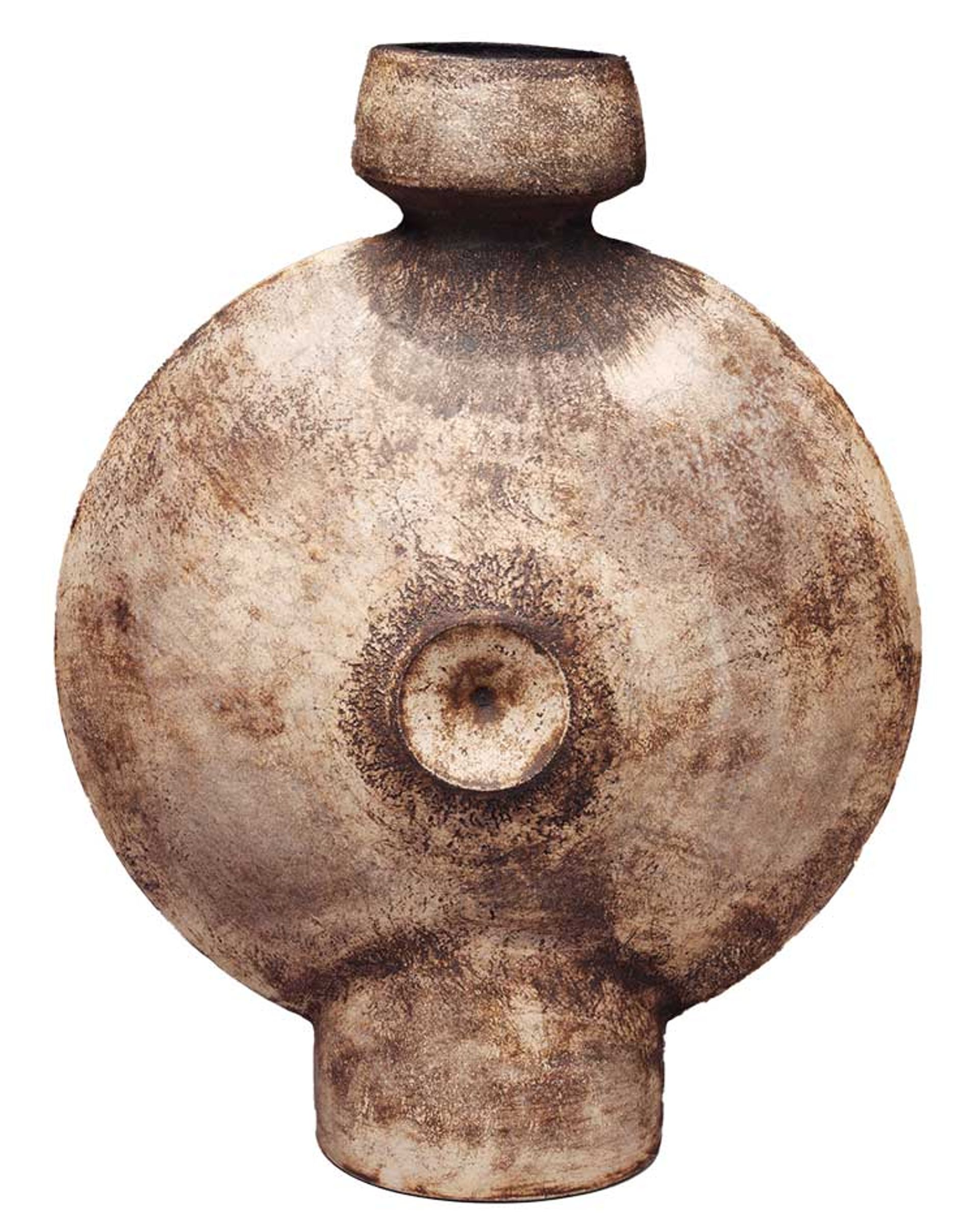British studio ceramics—ceramics designed and made by hand in a studio, by a single person or small team, as opposed to more streamlined objects produced in a factory—can now boast a history extending a little over a century. This handsome book by Alun Graves, the senior curator of ceramics and glass 1900-now at London’s Victoria and Albert Museum (V&A), catalogues the full holdings of studio ceramics at the museum acquired through purchase or gift since shortly before the 1920s. Graves builds on (and pays respectful homage to) the research of his predecessor at the museum, Oliver Watson, who produced a pioneering volume in 1990 on the same subject (British Studio Pottery: the Victoria and Albert Museum Collection, Phaidon/V&A).
In charting the growth of the collection over the three decades since Watson’s book appeared, Graves’s catalogue, as noted by the craft historian Tanya Harrod in her foreword, reflects the accompanying repositioning of ceramics within the fine art world. Thus the catalogue no longer has a sub-section towards the end covering the work of “fine art” ceramicists. Instead these pieces (by, for example, Barry Flanagan and John Piper) are integrated into the main catalogue, accompanied by more recently acquired works by Richard Deacon, Laura Ford and Jesse Wine, among others.
Graves has also widened the catalogue’s scope to include works by Roger Fry and the Omega Workshops, together with examples by Bloomsbury artists Duncan Grant and Vanessa Bell, as well as figurines of the 1920s and 30s made by a group of Chelsea-based potters; notably Charles Vyse and his wife Nell. The latter now sit alongside more recent acquisitions of figurative work in the collections by, for example, Philip Eglin, Claire Partington and Rachel Kneebone. Reinforcing this much enlarged range of ceramics, the catalogue even includes, as noted by Harrod, acquisitions from performative events arranged by artists such as Clare Twomey and Keith Harrison.

German-born British potter Hans Coper’s stoneware Large flat bottle (1958)
Photo: Richard Davis © Victoria and Albert Museum
Being an updated version of Watson’s earlier catalogue, Graves’s volume is organised along similar lines. The bulk of the catalogue is accordingly made up of an alphabetical listing of makers. As was the case for Watson’s catalogue, Graves has provided for each maker a biographical timeline, a brief assessment of the work and its contribution to the field of ceramics (occasionally longer for key artists such as Bernard Leach, Lucy Rie and Hans Coper), followed by a bibliography and a listing of the examples in the museum. Graves’s bibliographical entries are a phenomenon in themselves. Much of the “literature” (especially for the earlier makers) is in ephemeral formats such as pamphlets, invitation cards, typed listings and so on, which has necessitated his having to mine the resources of the National Art Library and other V&A departmental archives. These comprehensive listings will prove invaluable to future researchers.
Tracking the market
Moreover Graves (like Watson) provides details of prices paid (and most objects acquired by purchase generally entered the collections within up to four years after they were made), which will allow the future historian to track the changing market. Not every catalogued vessel is reproduced, but those that are (the majority) are all—unlike in the previous volume—in colour. The only regrettable omission is an accompanying appendix of potters’ marks and so for this the reader will need to consult the Watson volume.
For all its scholarly detail, Graves’s book is by no means limited in its appeal to specialists. The catalogue section is preceded by 149 magnificent colour plates organised broadly by chronology, and boasting many an attractive double-page spread where like is juxtaposed with like. The plates are preceded by a thoughtful essay by Graves that manages to convey in a limited word length many of the significant strands in the evolving story of British ceramics over the past hundred years. As well as describing the key makers and their work, he interweaves a discussion of the rise of courses for teaching ceramics in the art schools and elsewhere. Graves also charts the emergence of funding bodies and the growth of retail outlets. Above all, he engages with some of the theoretical debates about ceramics in terms of classification. Are ceramics art or craft? Might they be thrown, coiled or hand-built? Vessel or sculpture? Functional or non-functional? Traditional or “progressive”?
By the 1980s, these sorts of debates had often become heated, or subject to factional politics. However, as Graves points out, the impact of the fine-art trained Grayson Perry winning the Turner Prize in 2003 was “seismic”, eventually leading to a wider acceptance of what a ceramic object might be. Not only could ceramics be included in performative events orchestrated by artists, they might be assembled together in multiples, as installations, perhaps incorporated into architectural settings, as demonstrated by the work of Edmund de Waal, now as widely known as an author as a potter/artist.
If British ceramics are today more mainstream than 30 years ago, they are also more various in their inspiration and forms. Graves demonstrates how much the world of British studio ceramics has changed, or transformed, since the publication of Watson’s book. A traditional thrown vessel in the Leach tradition now sits happily alongside a highly experimental one more consciously addressed to a contemporary audience.
- Anne Lyles was a curator at the British Museum and Tate Britain and is a collector of British studio pottery
- Alun Graves, Studio Ceramics (Victoria and Albert Museum): British Studio Pottery 1900 to Now, Thames & Hudson/V&A, 416pp, 918 colour illustrations, £65/$85, published UK 6 April, US 6 June
